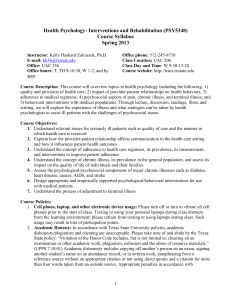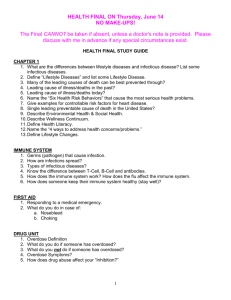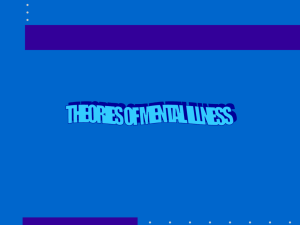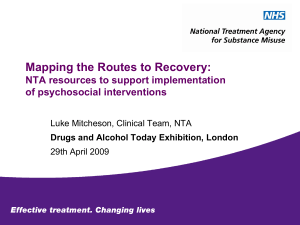BIOPSYCHOSOCIAL MODEL IN MEDICAL PRACTICE
advertisement
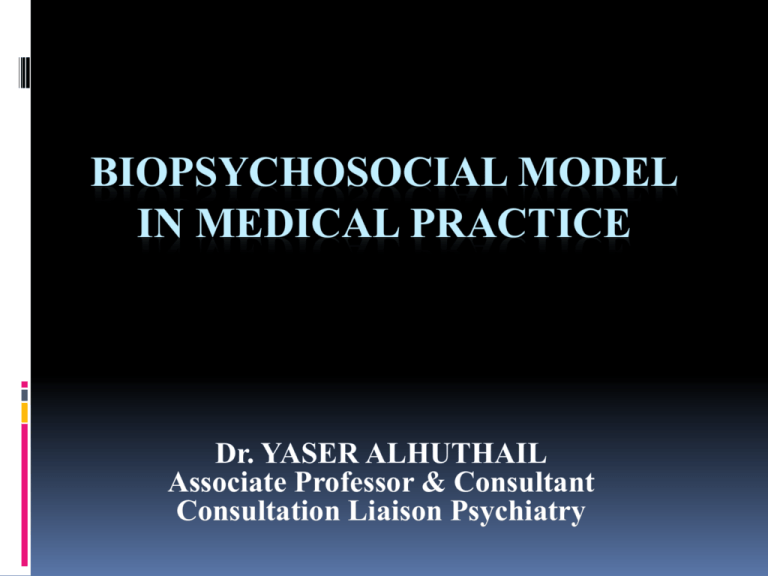
BIOPSYCHOSOCIAL MODEL IN MEDICAL PRACTICE Dr. YASER ALHUTHAIL Associate Professor & Consultant Consultation Liaison Psychiatry Biomedical Model: The application of biological science to maintain health and treating disease. Engel (1977) proposed a major change in our fundamental model of health care. The new model continues the emphasis on biological knowledge, but also encompasses the utilization of psychosocial knowledge. “Biopsychosocial Model” Implications: Unity of mind and body: Psychosocial factors must be taken into account when considering all disease states Emphasis on examining and treating the whole patient, not just his or her disease or disorder. Most illness, whether physical or psychological, is influenced and determined by biological, psychological, and social factors Biological, psychological, and social variables influence the predisposition, onset, course, and outcome of the illness Physicians who are able to evaluate the relationship of these variables to their patients illnesses will be able to develop more effective therapeutic interventions and to achieve better outcomes Psychological and Behavioral Predisposition to Physical Illness Life style, smoking, alcohol, substance abuse, eating habits, lack of exercise etc account for about 70% Of all cases of illness and death in the states Obesity Personality factors: Type A !! Onset of illness The role of stress Stress can be described as a circumstance that disturbs, or is likely to disturb, the normal physiological or psychological functioning of a person. The adaptive capacity of the person THE STRESS MODEL A psychosomatic framework. Two major facets of stress response. “Fight or Flight” response is mediated by hypothalamus, the sympathetic nervous system, and the adrenal medulla. If chronic, this response can have serious health consequences. The hypothalamus, pituitary gland, the adrenal cortex mediate the second facet. Neurotransmitter Responses to Stress Stressors activate noradrenergic systems in the brain and cause release of catecholamines from the autonomic nervous system. Stressors also activate serotonergic systems in the brain, as evidenced by increased serotonin turnover. Stress also increases dopaminergic neurotransmission in mesoprefrontal pathways. Endocrine Responses to Stress CRF is secreted from the hypothalamus. CRF acts at the anterior pituitary to trigger release of ACTH. ACTH acts at the adrenal cortex to stimulate the synthesis and release of glucocorticoids. Promote energy use, increase cardiovascular activity, and inhibit functions such as growth, reproduction, and immunity. Immune Response to Stress Inhibition of immune functioning by glucocorticoids. Stress can also cause immune activation through a variety of pathways including the release of humoral immune factors (cytokines) such as interleukin-1 (IL1) and IL-6. These cytokines can themselves cause further release of CRF, which in theory serves to increase glucocorticoid effects and thereby self-limit the immune activation. High level of Cortisol results in suppression of immunity which can cause susceptibility to infections and possibly also in many types of cancer. Changes in the immune system in response to stress are now very well established. Course and Outcome of Illness Direct vs. Indirect effect Stressful life events Social support Their combination: 4 times increased mortality post MI Mental disorders: course, mortality, health care utilization, LOS, ER visits, etc Psychosocial Interventions Numerous studies indicate that psychosocial interventions positively affect health outcomes Supportive, educational, or psychotherapeutic interventions Psychobiological Mechanisms Too many HOWs ?!! Theories !!.. Exact mechanisms!!.. Further research……... SUMMARY Multidimensional Approach Psychosocial influences are well established Multifaceted impact Proper communication Education and support
![stress response]](http://s2.studylib.net/store/data/010024037_1-8c1f8a9db34b15333b06e0b24d6f9abc-300x300.png)



